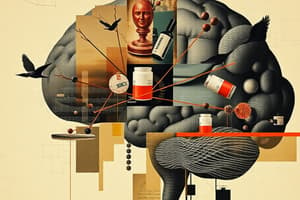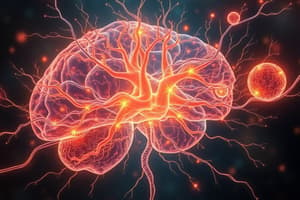Podcast
Questions and Answers
Which of these options are correct about the autonomic nervous system (ANS) when compared to the somatic nervous system?
Which of these options are correct about the autonomic nervous system (ANS) when compared to the somatic nervous system?
- The ANS operates without conscious control, while the somatic nervous system requires conscious effort. (correct)
- The ANS uses acetylcholine as its primary neurotransmitter, while the somatic nervous system uses norepinephrine.
- The ANS is responsible for regulating heart rate and digestion, while the somatic nervous system controls skeletal muscle movement. (correct)
- The ANS controls voluntary muscle movement, while the somatic nervous system controls involuntary functions.
Which of the following is NOT a function of the autonomic nervous system?
Which of the following is NOT a function of the autonomic nervous system?
- Maintaining body temperature
- Controlling skeletal muscle contraction (correct)
- Regulating blood pressure
- Adjusting digestion
What is the primary neurotransmitter of the parasympathetic nervous system?
What is the primary neurotransmitter of the parasympathetic nervous system?
- Epinephrine
- Acetylcholine (correct)
- Dopamine
- Norepinephrine
Which of these is a primary function of the sympathetic nervous system?
Which of these is a primary function of the sympathetic nervous system?
Which of the following statements accurately describes the role of adrenergic receptors in the autonomic nervous system?
Which of the following statements accurately describes the role of adrenergic receptors in the autonomic nervous system?
Which of the following represents a potential pharmacotherapeutic effect of drugs targeting the autonomic nervous system?
Which of the following represents a potential pharmacotherapeutic effect of drugs targeting the autonomic nervous system?
Which of the following is a potential off-target effect of a drug targeting the autonomic nervous system?
Which of the following is a potential off-target effect of a drug targeting the autonomic nervous system?
Which of the following correctly describes the synthesis, release, and degradation of acetylcholine (ACh) in the autonomic nervous system?
Which of the following correctly describes the synthesis, release, and degradation of acetylcholine (ACh) in the autonomic nervous system?
What is the primary function of parasympathomimetic drugs?
What is the primary function of parasympathomimetic drugs?
Which of the following is a common side effect of cholinergic drugs?
Which of the following is a common side effect of cholinergic drugs?
Which statement correctly differentiates between adrenergic and cholinergic receptors?
Which statement correctly differentiates between adrenergic and cholinergic receptors?
What are the primary neurotransmitters of the autonomic nervous system?
What are the primary neurotransmitters of the autonomic nervous system?
What is a potential off-target effect of beta-blockers?
What is a potential off-target effect of beta-blockers?
What type of fibers are long in the parasympathetic division and short in the sympathetic division?
What type of fibers are long in the parasympathetic division and short in the sympathetic division?
Which neurotransmitter is primarily released at postganglionic synapses in the sympathetic nervous system?
Which neurotransmitter is primarily released at postganglionic synapses in the sympathetic nervous system?
Which receptor type is associated with vasoconstriction and inhibition of norepinephrine release?
Which receptor type is associated with vasoconstriction and inhibition of norepinephrine release?
What is the correct sequence of synthesis for catecholamine neurotransmitters starting from tyrosine?
What is the correct sequence of synthesis for catecholamine neurotransmitters starting from tyrosine?
Which type of receptor is found in autonomic ganglia and the neuromuscular junction?
Which type of receptor is found in autonomic ganglia and the neuromuscular junction?
Which enzymes are responsible for the metabolism of catecholamines?
Which enzymes are responsible for the metabolism of catecholamines?
Which of the following drugs mimics sympathetic activation?
Which of the following drugs mimics sympathetic activation?
In which system do cholinergic fibers play a role in synaptic signaling?
In which system do cholinergic fibers play a role in synaptic signaling?
Flashcards
Autonomic Nervous System (ANS)
Autonomic Nervous System (ANS)
Regulates involuntary physiological processes like heart rate and digestion.
Sympathetic Nervous System (SNS)
Sympathetic Nervous System (SNS)
Part of the ANS responsible for 'fight or flight' responses.
Parasympathetic Nervous System (PNS)
Parasympathetic Nervous System (PNS)
Part of the ANS that promotes 'rest and digest' activities.
Cholinergic Receptors
Cholinergic Receptors
Signup and view all the flashcards
Parasympathomimetic Drugs
Parasympathomimetic Drugs
Signup and view all the flashcards
Adrenergic Receptors
Adrenergic Receptors
Signup and view all the flashcards
Parasympatholytic Drugs
Parasympatholytic Drugs
Signup and view all the flashcards
Adrenergic Drugs
Adrenergic Drugs
Signup and view all the flashcards
Central Nervous System (CNS)
Central Nervous System (CNS)
Signup and view all the flashcards
Peripheral Nervous System (PNS)
Peripheral Nervous System (PNS)
Signup and view all the flashcards
Cholinergic Drugs
Cholinergic Drugs
Signup and view all the flashcards
Homeostasis
Homeostasis
Signup and view all the flashcards
Beta-blockers
Beta-blockers
Signup and view all the flashcards
Preganglionic Fibers
Preganglionic Fibers
Signup and view all the flashcards
Postganglionic Fibers
Postganglionic Fibers
Signup and view all the flashcards
Sympathetic Division
Sympathetic Division
Signup and view all the flashcards
Parasympathetic Division
Parasympathetic Division
Signup and view all the flashcards
Cholinergic Fibers
Cholinergic Fibers
Signup and view all the flashcards
Adrenergic Fibers
Adrenergic Fibers
Signup and view all the flashcards
Sympathomimetic Drugs
Sympathomimetic Drugs
Signup and view all the flashcards
Study Notes
Introduction to Autonomic Pharmacology
- The autonomic nervous system (ANS) controls involuntary processes like heart rate, blood pressure, respiration, and digestion.
- It works alongside the somatic nervous system, which controls voluntary movements.
- The ANS is divided into two main divisions: the sympathetic (SNS) and parasympathetic (PNS) nervous systems.
- The SNS is often associated with the "fight-or-flight" response, while the PNS is linked to the "rest-and-digest" response.
- Figure 1 shows the organization of the ANS, illustrating the pathways, neurotransmitters, and target organs of the sympathetic & parasympathetic systems.
Objectives
- Identify and describe the functions of the components of the nervous system.
- Explain the role of the sympathetic and parasympathetic nervous systems.
- Describe the synthesis, release, and degradation of autonomic neurotransmitters.
- Distinguish between cholinergic and adrenergic receptors.
- Recognize the implications of autonomic drugs on the body.
Organization of the Nervous System
- The central nervous system (CNS) includes the brain and spinal cord.
- The peripheral nervous system (PNS) contains neuronal tissues outside the CNS.
- The PNS is further divided into the autonomic nervous system (ANS) and somatic nervous system, controlling involuntary and voluntary functions, respectively.
- Figure 2 shows an illustrative diagram of the CNS, PNS, and their subdivisions.
Autonomic Nervous System
- The autonomic nervous system regulates various involuntary functions.
- The sympathetic nervous system (SNS) is associated with the "fight or flight" response.
- The parasympathetic nervous system (PNS) is associated with the "rest and digest" response.
Organization of Autonomic Nervous System
- The sympathetic division originates in the thoracic and lumbar spinal cord.
- The sympathetic division utilizes acetylcholine (ACh) at preganglionic synapses, and norepinephrine (NE) at postganglionic synapses. - The parasympathetic division originates in the brainstem and sacral spinal cord.
- The parasympathetic division utilizes acetylcholine (ACh) at both preganglionic and postganglionic synapses.
- Figure 4 illustrates differences in neuron lengths and neurotransmitters used in sympathetic and parasympathetic pathways.
Neurotransmitter Chemistry of the ANS
- Cholinergic fibers release acetylcholine (ACh), including all preganglionic fibers, some postganglionic parasympathetic fibers, and at neuromuscular junctions.
- Adrenergic fibers release norepinephrine (NE), primarily from postganglionic sympathetic fibers.
- Other neurotransmitters, like dopamine and epinephrine, also play a role in the ANS.
- Figure 5 details neurotransmitters and their targets.
Catecholamine Neurotransmitters
- Catecholamine synthesis begins with tyrosine, producing dopamine, norepinephrine, and epinephrine.
- Monoamine oxidase (MAO) and catechol-O-methyltransferase (COMT) degrade catecholamines.
- Figure 6 illustrates the pathway of catecholamine synthesis.
Receptors
- Cholinergic receptors include nicotinic (N) receptors in ganglia and synapses and muscarinic (M) receptors in target organs.
- Adrenergic receptors include alpha (α) and beta (β) receptors, each impacting different bodily functions.
- Figure 7 shows receptor types and their functions.
Pharmacotherapeutic Implications
- Sympathomimetic drugs mimic sympathetic activity.
- Sympatholytic drugs block sympathetic activity.
- Parasympathomimetic drugs enhance parasympathetic activity.
- Parasympatholytic drugs inhibit parasympathetic activity.
Off-Target Effects
- Some drugs affecting the autonomic nervous system can induce secondary, often unwanted, effects (e.g., hypertension, anxiety, blurred vision).
Summary
- ANS is crucial for homeostasis and bodily functions.
- The ANS involves neurotransmitters for signaling.
- Receptor specificity is critical for targeted drug actions.
Review Questions
- What are the primary neurotransmitters of the autonomic nervous system?
- How do adrenergic and cholinergic receptors differ in function?
- What is the function of the adrenal medulla in autonomic pharmacology?
- How do sympathomimetic and sympatholytic drugs differ?
- What are some common side effects of drugs affecting the ANS?
Studying That Suits You
Use AI to generate personalized quizzes and flashcards to suit your learning preferences.




